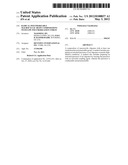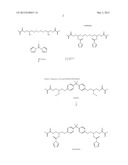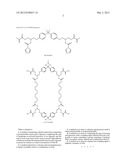Patent application title: RADICAL POLYMERIZABLE MACROCYCLIC RESIN COMPOSITIONS WITH LOW POLYMERIZATION STRESS
Inventors:
Xiaoming Jin (Middletown, DE, US)
Xiaoming Jin (Middletown, DE, US)
Paul D. Hammesfahr (Wyoming, DE, US)
Assignees:
DENTSPLY INTERNATIONAL INC.
IPC8 Class: AC07C6800FI
USPC Class:
558267
Class name: Plural -o-c(=o)o- groups attached indirectly to each other by nonionic bonding additional chalcogen attached indirectly to one of the -o-c(=o)o- groups by acyclic nonionic bonding the additional chalcogen, x, is in a -c(=x)- group
Publication date: 2012-05-03
Patent application number: 20120108837
Abstract:
A composition of macrocyclic oligomer with at least one (meth)acrylate
polymerizable group. A method includes preparing an activated precursor
of an oligomer at pseudo high-dilution conditions. A method also includes
preparing an activated precursor of an oligomer by reacting the precursor
with an activated coupling agent, wherein the precursor is condensable
and polymerizable.Claims:
1. A method of preparing a dental composition comprising a polymerizable
macrocyclic oligomer, comprising the step of preparing an activated
precursor of an oligomer and the step to form such macrocyclic resin at
pseudo high-dilution conditions such that the polymerizable macrocyclic
oligomer is present in solution at a final concentration of 0.02 M.
2. A method claimed in 1, wherein said activated precursor is liquid, crystalline solid or a combination of both.
3. A method as in claim 1, wherein said precursor itself is either polymerizable or nonpolymerizable.
4. A method as in claim 1, comprising the step of reacting said precursor with a coupling agent selected from the compounds or resins containing a group consisting of primary diols, secondary amines, diacids and combinations thereof.
5. A method as in claim 4, wherein said coupling agent is aliphatic, aromatic or both.
Description:
RELATED APPLICATIONS
[0001] This is a Continuation Application which claims priority to U.S. Ser. No. 12/912,951, which claims priority to U.S. Ser. No. 12/655,028 filed on Dec. 22, 2009, now abandoned, which claims priority to U.S. Ser. No. 12/381,781 filed on Mar. 16, 2009, now abandoned, which claims priority to U.S. Ser. No. 12/079,525 filed on Mar. 27, 2008, now abandoned, which in turn claims priority to U.S. Ser. No. 11/153,090 filed on Jun. 15, 2005, now abandoned, which in turn claims priority to provisional patent application Ser. No. 60/579,836 filed on Jun. 15, 2004, now abandoned.
FIELD OF THE INVENTION
[0002] This invention relates to free radical polymerizable macrocyclic compounds and composition, which feature by their low shrinkage and low contraction stress upon polymerization. Such low shrinkage and low stress resin could find their wide range of applications, especially in microelectronic, special coating and restorative dentistry where the dimensional stability and contraction stress within cured materials are critical to the total performance.
BACKGROUND OF THE INVENTION
[0003] The polymerization shrinkage of curable material is referred to the dimensional contraction during polymerization or curing, because the formation of covalent bonding during polymerization bring the molecules closer each other than that while they are free in van der Walls distance. The origin of polymerization stress, on the other hand, comes from a restrained polymerization or shrinking during curing. Therefore, it is not only related to polymerization shrinkage, but also is dependent on the polymerization kinetics.
[0004] It is well known that with increasing molecular weight, the mobility of polymeric chain would be limited, the diffusion is becoming the rate control factor. In addition, such a limited mobility in a cross-linking system appear to come earlier in comparison with linear system, which means extra reaction would lead to an increasing polymerization stress. There are different ways to control the stress generation and development: [0005] 1. Slow down the polymerization rate; [0006] Introducing a special rate controller like stable radicals; [0007] Creating different polymerization zones from which the stress developed in a polymerized zone could be transferred to its adjacent unpolymerized zone and got relief like segmental polymerization technique; [0008] Employing different polymerization groups; [0009] Using large-size macromonomer to limited its reactivity at the early stage; [0010] 2. Reduce the conversion; [0011] Pre-building a 2D or 3D structure like macrocyclics, dendrimers or hyperbranches; [0012] 3. Limiting the cross-link density to offer acceptable mechanical property.
[0013] To reduce polymerization shrinkage and stress in the specific dental restorative composite, all of above approaches are taking into account. In this invention, however, the objective is to present a general method to produce a macrocyclic oligomer which would be converted into 3D network via free radical polymerization.
[0014] U.S. Pat. No. 4,644,053, disclosed a method to synthesize single macrocyclic compounds. Then various macrocyclics oligomers, including carbonates, esters, amides, ethers, imides, sulfides, et al, have been prepared. However, high temperature ring-opening reaction has to be involved to convert these macrocyclics into high molecular weight polymers.
[0015] U.S. Pat. No. 5,047,261, disclosed a composition containing a five-member carbonate cyclic group for fast copolymerization with mathacrylate.
[0016] U.S. Pat. No. 5,792,821, disclosed polymerizable cyclidextrin (CD) derivatives, in which methacrylate was attached on CD.
[0017] U.S. Pat. No. 5,962,703, disclosed functionalized bicyclic methacrylate with norboneyl or norbonadienl group.
[0018] U.S. Pat. No. 6,043,361, disclosed polymerizable cyclic allylic sufides is used for low shrinkage materials.
Approach
[0019] The macrocyclic oligomers are prepared under pseudo-high-dilution condition via a condensation between a reactive and free radical polymerizable precursor and various coupling agents to afford carbonate, ester, siloxane, phosphonate, et al linkages to result in macrocyclic oligomers. To avoid the premature polymerization of methacrylate groups, the condensation groups usually have to be activated to assure a mild reaction for cyclization with the coupling monomers.
[0020] BisGMA is one of widely used dental resin and it contains two free radical polymerizable group, methacrylate and two hydroxyl groups. This turns BisGMA an ideal candidate for polymerizable macrocyclic oligomer, although the presence of BisGMA isomer would make more complicated to this approach. As shown in Scheme I, carbonyldiimidazol (CDI, 1), was used to selectively reacted with the secondary alcohol in BisGMA (2) to give an activated BisGMA, DIZ-BisGMA(3). It was isolated and the chemical structure of DIZ-BisGMA was fully characterized with FITR and NMR. Actually, according to the recent report by Davis et al of Courtlaulds, England, CDI and its intermediates could exhibit .surprisingly specificity towards primary, secondary, tertiary functional groups, of the same type, during the controlled formation of various well-defined molecular sequence. Our idea is to adopt same chemistry of CDI and to activate the two secondary hydroxyl group. Furthermore, an activated precursor, DIZ-BisGMA, was made to react with various primary diols 1,10-decanediol, under a pseudo high-dilution condition, as shown in Scheme II. Both reactants were simultaneously charged into the system in a high-dilution condition via slowly, precisely controlled addition to ensure a favorable formation of cyclic product. Since the product, C10-CYCBGM (5), is accumulated with a final concentration of 0.02M, which is much higher than the classical high dilution condition (0.001M), this procedure is, therefore, referred as pseudo-high-dilution approach. Since imidazol is produced from both precursor and cyclization steps, a continuous process was successfully developed without direct separation of DIZ-BisGMA.
##STR00001##
##STR00002##
##STR00003##
User Contributions:
Comment about this patent or add new information about this topic:
| People who visited this patent also read: | |
| Patent application number | Title |
|---|---|
| 20220223107 | PIXEL CIRCUIT AND DRIVE METHOD THEREOF, AND DISPLAY PANEL |
| 20220223106 | DISPLAY DEVICE AND DRIVING METHOD THEREOF |
| 20220223105 | DRIVING METHOD AND APPARATUS OF A DISPLAY PANEL |
| 20220223104 | PIXEL DEGRADATION TRACKING AND COMPENSATION FOR DISPLAY TECHNOLOGIES |
| 20220223103 | METHODS, APPARATUS, AND ARTICLES OF MANUFACTURE TO CONTROL A MICRO-LED DISPLAY |



